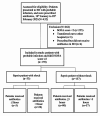An observational study on the impact of overcrowding towards door-to-antibiotic time among sepsis patients presented to emergency department of a tertiary academic hospital
- PMID: 38609924
- PMCID: PMC11015690
- DOI: 10.1186/s12873-024-00973-4
An observational study on the impact of overcrowding towards door-to-antibiotic time among sepsis patients presented to emergency department of a tertiary academic hospital
Abstract
Background: The latest Surviving Sepsis Campaign 2021 recommends early antibiotics administration. However, Emergency Department (ED) overcrowding can delay sepsis management. This study aimed to determine the effect of ED overcrowding towards the management and outcome of sepsis patients presented to ED.
Methods: This was an observational study conducted among sepsis patients presented to ED of a tertiary university hospital from 18th January 2021 until 28th February 2021. ED overcrowding status was determined using the National Emergency Department Overcrowding Score (NEDOCS) scoring system. Sepsis patients were identified using Sequential Organ Failure Assessment (SOFA) scores and their door-to-antibiotic time (DTA) were recorded. Patient outcomes were hospital length of stay (LOS) and in-hospital mortality. Statistical analysis was done using Statistical Package for Social Sciences (SPSS) version 26. P-value of less than 0.05 for a two-sided test was considered statistically significant.
Results: Total of 170 patients were recruited. Among them, 33 patients presented with septic shock and only 15% (n = 5) received antibiotics within one hour. Of 137 sepsis patients without shock, 58.4% (n = 80) received antibiotics within three hours. We found no significant association between ED overcrowding with DTA time (p = 0.989) and LOS (p = 0.403). However, in-hospital mortality increased two times during overcrowded ED (95% CI 1-4; p = 0.041).
Conclusion: ED overcrowding has no significant impact on DTA and LOS which are crucial indicators of sepsis care quality but it increases overall mortality outcome. Further research is needed to explore other factors such as lack of resources, delay in initiating fluid resuscitation or vasopressor so as to improve sepsis patient care during ED overcrowding.
Keywords: Door-to-antibiotic time; ED overcrowding; In-hospital mortality; Length of hospital stay; Sepsis.
© 2024. The Author(s).
Conflict of interest statement
The authors declare no competing interests.
Figures
Similar articles
-
Impact of extended emergency department stay on antibiotic re-dosing delays and outcomes in sepsis.Am J Emerg Med. 2022 May;55:32-37. doi: 10.1016/j.ajem.2022.02.028. Epub 2022 Feb 24. Am J Emerg Med. 2022. PMID: 35255455
-
The DISPARITY-II study: delays to antibiotic administration in women with severe sepsis or septic shock.Acad Emerg Med. 2014 Dec;21(12):1499-502. doi: 10.1111/acem.12546. Epub 2014 Nov 25. Acad Emerg Med. 2014. PMID: 25424151
-
Development of an Emergency Department Surge Plan Based on the NEDOCS score.Ann Fam Med. 2024 Nov 1;21(Suppl 3):4789. doi: 10.1370/afm.22.s1.4789. Ann Fam Med. 2024. PMID: 38271089 Free PMC article.
-
Does Early and Appropriate Antibiotic Administration Improve Mortality in Emergency Department Patients with Severe Sepsis or Septic Shock?J Emerg Med. 2017 Oct;53(4):588-595. doi: 10.1016/j.jemermed.2016.12.009. Epub 2017 Sep 12. J Emerg Med. 2017. PMID: 28916120 Review.
-
A quality improvement project to improve early sepsis care in the emergency department.BMJ Qual Saf. 2015 Dec;24(12):787-95. doi: 10.1136/bmjqs-2014-003552. Epub 2015 Aug 6. BMJ Qual Saf. 2015. PMID: 26251506 Review.
Cited by
-
Factors associated with delayed order-to-administration time in the emergency department: a retrospective analysis.BMC Emerg Med. 2025 Apr 28;25(1):74. doi: 10.1186/s12873-025-01229-5. BMC Emerg Med. 2025. PMID: 40295912 Free PMC article.
References
Publication types
MeSH terms
Substances
LinkOut - more resources
Full Text Sources
Medical





